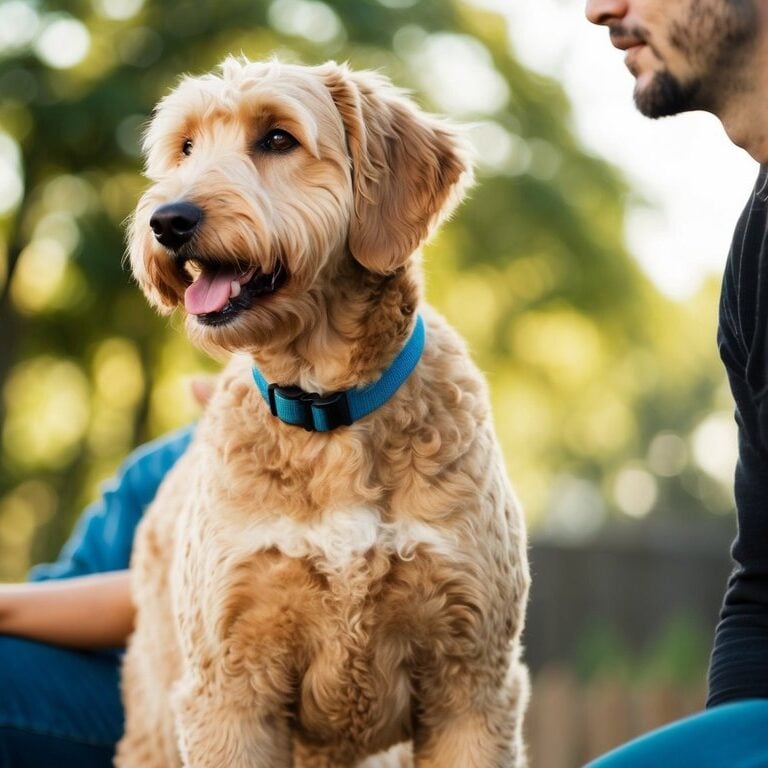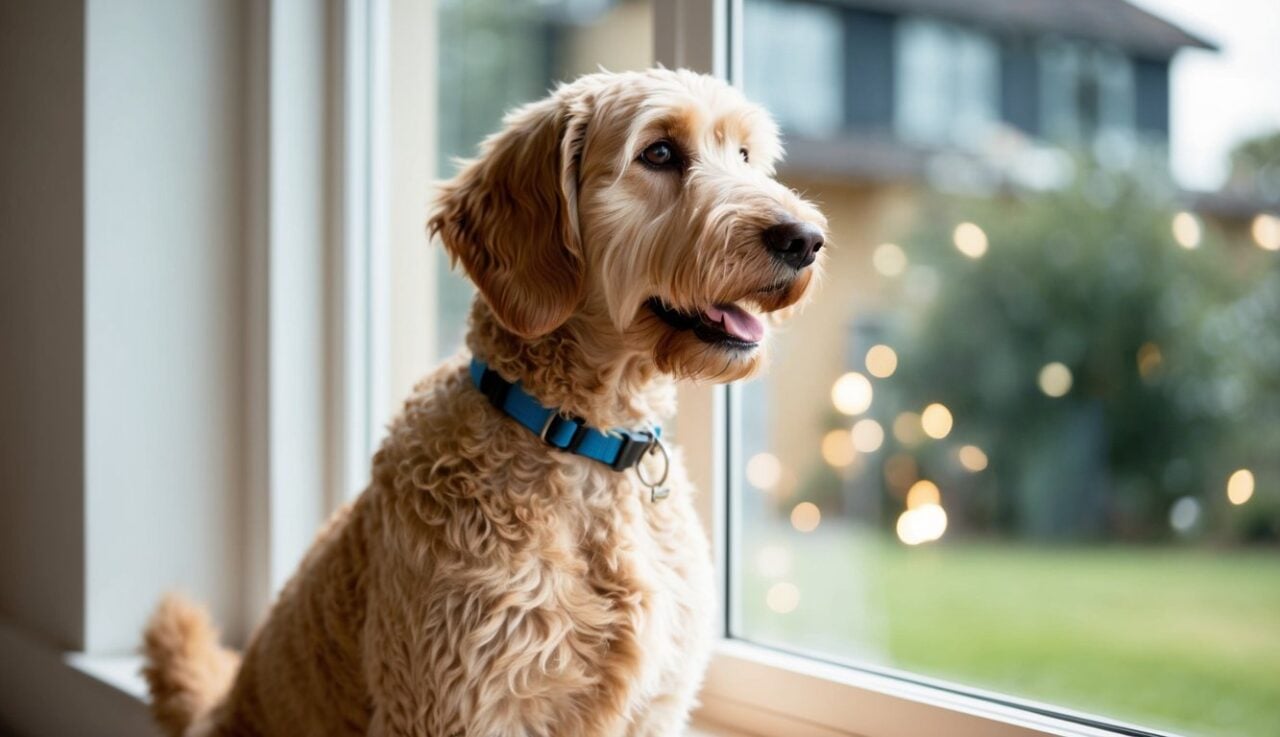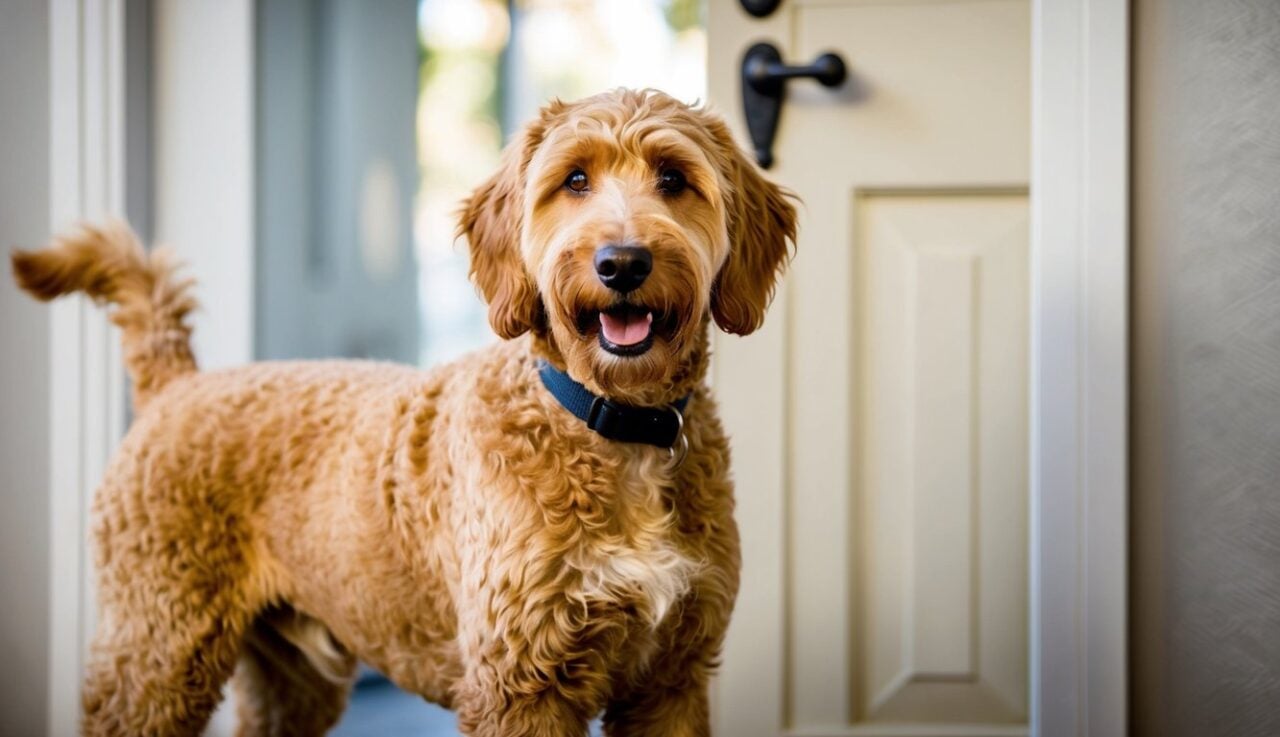Are Goldendoodles Protective Of Their Owners? My Experience
If you’ve ever seen your Goldendoodle stand between you and a stranger at the park, you might wonder, “Will my Doodle really protect me if it counts?” Watching Lexie’s goofy grin most days, it’s hard for us to picture her as a guard dog. But every now and then, she’ll surprise us with a bark or a quick lean against our legs, as if she’s making sure we’re safe.

We’re digging into a question many Doodle owners ask themselves: are Goldendoodles protective of their owners, or are they just here for the belly rubs? Goldendoodles are usually friendly and social, but they can develop protective instincts for their families, even though they aren’t natural guard dogs—that little spark of loyalty is real, even if it comes with a tail wag. In this post, we’ll share what we’ve learned about love, loyalty, and a Goldendoodle’s take on “protection” after years with Lexie by our side.
So if you’re curious about what makes these dogs tick—or just want to know if your Doodle is secretly your bodyguard—you’re in the right place. We’ll share our honest experiences, a few surprises, and some tips for encouraging the best traits in your Goldendoodle.
What Does Protective Mean For Goldendoodles?
When we talk about Goldendoodles being “protective,” it doesn’t mean they act like fierce guard dogs. Instead, their version of protection often looks more like alertness, loyalty, and a gentle sense of responsibility for us.
They show their devotion in different ways, from keeping an eye on the house to sticking by our side when something feels unfamiliar.
Common Signs Of Protective Behavior
With Lexie, we’ve learned that “protective” for a Goldendoodle usually doesn’t involve barking at strangers or trying to chase off mail carriers. Instead, we notice small but meaningful signs:
- Shadowing: Lexie follows us room to room, even in the bathroom. If we’re home alone, she always seems a little extra alert.
- Alertness: When there’s a new sound outside, her head pops up. She’ll watch the door, but won’t bark unless she really feels we need to know.
- Gentle Blocking: Sometimes, Lexie will stand between us and someone new. She’s never aggressive, just cautious until she senses good vibes.
- Comforting: Whenever someone in our family feels sad or scared (yep, including thunderstorm nights), Lexie is right there, leaning against us.
It’s a tender kind of watchfulness. Most Goldendoodles aren’t aggressive or overly protective, but they do have a knack for sensing when we need a calming presence.
How Goldendoodles Express Loyalty
If you share your life with a Goldendoodle, you already know how loyal these dogs can be. Lexie shows her loyalty by always wanting to be close—whether we’re cooking, watching TV, or heading out for a walk together.
We see her loyalty in the way she waits for us by the window when we leave, and in the excited tail wags when we return. It’s not unusual for her to “check in” during the day—she’ll nudge our hand or rest her chin on our knee just to make sure we’re okay.
Goldendoodles are known for their friendly personalities rather than strong protective instincts, but they form very close bonds with their families. Lexie’s brand of loyalty is gentle and steady, not dramatic. She’ll greet strangers with a wag or a sniff, but we always feel like she’s keeping an eye on things for us.
If you wonder whether your own Goldendoodle is protective, watch for those quiet acts of care—they’re easy to miss if you’re only looking for loud or bold behaviors. For more about what real-world Goldendoodle protection looks like, check out these insights on Goldendoodle protective behaviors.
Goldendoodle Temperament: My Life With Lexie

Living with our mini Goldendoodle, Lexie, has taught us that their reputation for being friendly and gentle is well-earned. Goldendoodles aren’t usually natural guard dogs, but we still see moments where Lexie’s loyalty and watchfulness shine through.
Relatable Moments Of Watchfulness
Lexie is not what most would call “protective” in an aggressive way. Still, she shows her loyalty with little acts of alertness. When someone comes to the door, Lexie always rushes over first. She won’t bark loudly, but she does let out a low “woof” and stands between us and the door—her signature move of curiosity and caution.
We once had a neighbor’s off-leash dog run up our driveway. Lexie put herself right in front of us and held this serious stance, her eyes locked on the newcomer. Even though she’s only 28 pounds soaking wet, that moment showed us her quiet form of “protection”: standing her ground without a hint of aggression.
Goldendoodles like Lexie are more likely to act as soft alarms than fierce protectors. She won’t scare off a stranger, but she’ll always be the first to tip us off that something’s different. These moments remind us we have a gentle companion who’s aware of her surroundings and our routines.
Why Socialization Matters
From the day Lexie came home, we made it a goal to help her feel comfortable around people, kids, and other dogs. Goldendoodles thrive on positive socialization. If we hadn’t focused on this early, Lexie might have developed nervous behaviors or become too clingy with us.
Socialization keeps her watchfulness from turning into anxiety. We took Lexie to puppy classes, the park, and stores that allow dogs. Meeting new people and pets helped her become confident and well-adjusted. Now, she might notice a delivery person or a neighbor passing by, but she isn’t afraid or aggressive—just curious and alert.
We always recommend other Goldendoodle families do the same. The more relaxed and outgoing your Doodle is, the healthier their protective instincts will be. Proper socialization gives Goldendoodles the best chance to be caring, calm companions who know when to trust and when to stand nearby with their sweet, watchful eyes.
Do Goldendoodles Make Good Guard Dogs?

Most of us love our Goldendoodles for how friendly and social they are. While they can surprise us with alert barking when someone approaches the door, being a guard dog is a different story.
Natural Instincts Versus Training
Goldendoodles, as a mix of Golden Retriever and Poodle, are bred mostly for companionship and friendliness—not protection. When someone comes to our front door, Lexie will always bark, alerting us right away. But after that, she’s wagging and waiting for pets, even from strangers.
Here’s what I’ve noticed with Lexie over the years:
- She’s great at letting us know when a package gets dropped off or if someone is outside.
- She’s quick to calm down as soon as she sees a friendly face.
- Goldendoodles rarely show aggression, which is common among the breed, and training only goes so far in making them “protective.”
Even with careful training, most Goldendoodles will stop at barking or standing between us and a stranger. They usually won’t act defensive or threatening like true guard dogs. Goldendoodles can sometimes be protective, but their sweet nature means they’re more likely to offer a guest a toy than a warning.
Comparing Goldendoodles To Traditional Guard Breeds
People sometimes think a big, fluffy dog will naturally make a great guard dog. In truth, breeds like German Shepherds and Rottweilers have been bred for generations to guard and protect. They have strong instincts to watch over their homes.
Goldendoodles just aren’t wired the same way. They want to make friends, not foes. Lexie’s idea of “guarding” is greeting the mail carrier with her happiest tail wag. If we compared typical traits, it would look something like this:
| Trait | Goldendoodle | Traditional Guard Breeds |
|---|---|---|
| Protective Instincts | Low to Moderate | High |
| Territorial Behavior | Low | High |
| Stranger Aggression | Very Rare | Can be Moderate to High |
| Social with Strangers | Very High | Usually Low |
We can definitely count on our Goldendoodles to let us know when something’s up. But if you’re hoping for a dog that’ll scare off intruders, a doodle probably isn’t the right fit. We’ve learned to appreciate Lexie’s watchdog skills—and her love of everyone she meets.
Signs Your Goldendoodle Is Protective Of You

Goldendoodles like Lexie tend to show their protective side through small, specific actions. While they’re often known for being friendly, many of us notice little changes in their behavior when someone new comes around or when they think we might need their help.
Body Language Cues To Watch For
We always keep an eye on Lexie’s body language when guests arrive. Her stance is a big clue—if she stands between us and a stranger, even for just a second, it usually means she’s feeling protective. Sometimes her tail gets stiff even though it’s usually loose and waggy with friends.
When Lexie’s worried, her ears perk up and she’ll stare at the new person. She doesn’t bark much, but if she does, it’s a deeper, more serious bark—not her usual “play with me” sound. According to tips from other owners, some Doodles may freeze or even show their teeth in certain situations, though Lexie’s signs are more subtle. For more on classic signs, other Doodle parents can check out this list of protective behaviors in Goldendoodles.
We’ve also learned to watch for smaller signals: a paw on our foot, sitting extra close, or keeping an eye on the door. These cues are Lexie’s way of saying, “I’ve got your back,” even if she’d rather nap than guard the house.
How Lexie Responds To Strangers
Over the years, we’ve noticed that Lexie is usually quick to greet anyone with a tail wag. But when an unfamiliar visitor arrives—especially someone with a loud voice or strange energy—she’ll slow down and watch us closely before going to say hello.
Once, a repair person came by unannounced and Lexie stood right next to us the entire time. She didn’t growl or act aggressive, but she didn’t leave our side either. It was like she decided her job for the day was “shadowing” us until she was sure everything was safe.
If she gets really unsure, Lexie positions herself between us and the visitor, or sometimes retreats back and gives a soft, warning woof. We’ve come to see this as her “bodyguard mode,” even if she would never be truly fierce. If your Doodle reacts this way, it’s just their way of checking in and making sure the pack is okay. For more typical Doodle reactions, check out the experience of other owners who share that Goldendoodles often greet strangers happily, but can show subtle signs of protectiveness.
Factors That Influence Protective Behavior
A Goldendoodle’s urge to protect us comes from more than just good intentions. The way our Doodles act depends on things like their family tree and the world we give them to grow up in.
Genetics And Breed Mix
Goldendoodles are a mix between Golden Retrievers and Poodles, and both of these breeds bring different things to the table. Golden Retrievers are usually friendly and social. They rarely show natural guard dog instincts. Poodles are smart and also known more for their trainability than their protectiveness.
From what we’ve seen with our mini Goldendoodle Lexie, her friendly nature is definitely the biggest thing we notice every day. She’s always wagging her tail at visitors, but we do see her perk up if a delivery driver lingers too long near our yard. If your Doodle has more Poodle or Retriever traits, that can affect how protective they are.
Some Doodles can show a little more caution if they sense something unusual, but it’s rare for them to become aggressive or territorial. They’re more likely to bark and then instantly want to make a new friend. Genetics helps set the stage, but no two Doodles are exactly alike—Lexie is proof of that!
Environment And Upbringing
Environment plays a huge role in how protective our Doodles turn out. If a Goldendoodle grows up in a busy, loving home, they usually learn to trust people. Lexie, for example, was raised with lots of exposure to new faces at the park and neighborhood kids stopping by. Because of this, she’s quick to greet almost anyone, but she still keeps an eye on us if something feels off.
Socialization is key. Dogs who don’t get enough positive experiences with people or other animals may act nervous or overprotective. Consistent training helps too. When Lexie was a puppy, we practiced “quiet” and “leave it,” which came in handy the first time she heard the mail truck. She’s still alert, but now she knows there’s no need to panic.
Stressful or unstable environments can also shape behavior. We’ve seen in our neighborhood that rescue Goldendoodles sometimes take longer to settle in and trust strangers. Patience and routine make a big difference for these pups. The environment we create helps shape how safe, calm, and secure our Doodles feel—and that’s what influences their protective instincts more than anything else.
Training Tips For A Balanced, Confident Doodle
Finding the sweet spot between a friendly, alert Doodle and an overly watchful pup has been a journey for us. With Lexie, we learned a lot from trial and error, laughter, and a few chewed-up slippers along the way.
Encouraging Healthy Alertness
We’ve always wanted Lexie to be aware of her surroundings but not anxious or jumpy. One of the best habits we built early on was rewarding her calmly when she noticed something new, like the mail carrier, without reacting in fear or excitement. Using treats and praise helped her see these things as normal, not threats.
Routine socialization was key for us. When Lexie was a pup, we scheduled daily walks in different neighborhoods, visited pet-friendly stores, and invited friends over (with their dogs if possible). This showed her that the world is full of friendly faces.
We also taught basic commands like “watch me,” “settle,” and “leave it.” These are lifesavers during noisy neighborhood moments or when a squirrel launches a surprise attack on our backyard. Staying calm ourselves made a huge difference—Lexie always seemed to copy our moods.
If you want more tips, check out this guide on positive reinforcement and early socialization that lines up closely with what’s worked for us.
Managing Over-Protectiveness
We’ve seen firsthand that Goldendoodles can sometimes get a little too attached. When Lexie was younger, she’d bark at the front door for every package delivery. It took patience (and a lot of peanut butter) to help her relax.
Our best trick was teaching her a “safe spot”—her bed in the hallway—where she could retreat and chill out. Whenever the doorbell rang, we’d calmly guide Lexie there and reward her for staying put. Over time, she learned that our reactions, not the sound, mattered most.
Ignoring attention-seeking barking worked wonders. We stopped reinforcing her alerts with frantic “hush!” commands and instead saved the treats and praise for quiet moments.
Consistency really paid off. With a little practice, Lexie stopped responding to every bump and thump like it was a big deal. I’ve also read that starting early socialization and obedience training helps prevent over-protectiveness, and that matched what we experienced.
Challenges With Protective Behaviors
Living with a Goldendoodle means we sometimes face challenges when their protective side comes out. Our pups might bark at harmless noises or act anxious in new settings, even if they aren’t “guard dogs” by nature. These behaviors can be managed with some patience and the right approach.
Dealing With Unwanted Barking
If your house is anything like ours, the doorbell rings and Lexie launches into her security-guard routine—barking at full volume. Goldendoodles are not true protectors, but they can be alert and barky when they sense something unusual, especially since they want to make sure everyone is safe in their world.
The hardest part is the “false alarm” barking. Squirrels, the mail carrier, or even the neighbor’s car can set them off. We’ve learned that calmly acknowledging Lexie’s alert helps her settle: I’ll thank her, look out the window, and then redirect her to a favorite toy or treat. Consistency is key.
It’s also important not to yell, as that can make barking worse. Clickers, treats, or even a quiet “okay, all done” signal can help Goldendoodles understand when it’s time to stop. If barking is a struggle, training classes or a good trainer who understands doodle quirks may help.
Quick Tips
- Acknowledge and redirect
- Use positive reinforcement
- Practice quiet cues
Helping Nervous Doodles Feel Safe
We’ve gone through phases when Lexie seems jumpy—like during thunderstorms or when new people visit. Nervousness can show up as pacing, whining, or sticking close to us. While Goldendoodles aren’t known for being highly protective, they can still get anxious about their surroundings.
One thing that helps is creating a calm, safe space. Lexie has a soft bed in a quiet room where she can retreat if she wants. We use gentle, reassuring voices, and sometimes a favorite stuffed animal or blanket does wonders.
Routine is extra important for nervous Goldendoodles. Keeping feeding times, walks, and play predictable helps them feel more secure. When we know a trigger is coming—like a noisy delivery—I try to distract her with a game or treat puzzle.
If our doodle’s anxiety seems extreme, we have learned to consider a chat with the vet. Sometimes they can offer advice or resources that make a real difference.
Comfort Strategies
- Create a safe, cozy spot
- Stick to routines
- Distract with toys or food puzzles
- Seek help if anxiety is strong
Lexie has taught us that a little understanding and preparation go a long way when helping our doodle feel safe and happy at home.
How Age And Life Stages Affect Goldendoodle Protectiveness
When we brought Lexie home as a puppy, our focus was all about fun and training. At that stage, most Goldendoodles, like Lexie, are more playful than protective. Puppies are curious and might bark at new sounds, but it’s usually excitement, not guarding.
As our Doodles grow into teenagers (around 6-18 months), we notice a shift. They start to test boundaries and might become more alert at the door or to strangers. Lexie went through a “bark at the mailman” phase, but she was mostly trying out her new “big dog” skills.
By adulthood (about 2-7 years old), most Goldendoodles settle into their personality. Many are still not naturally protective like guard dog breeds, but we find them super loyal and tuned into our feelings. Lexie always sits close if we seem upset or sick.
Here’s a quick breakdown of what we’ve noticed:
| Life Stage | Common Behaviors | Protectiveness Level |
|---|---|---|
| Puppy | Playful, curious, excitable | Low |
| Teenage | Territorial barking, testing rules | Low to moderate |
| Adult | Calm, bonded, responsive | Moderate if needed |
| Senior | Relaxed, trusting, observant | Usually lower (but loyal) |
Now that Lexie is a senior, her energy is slower and she hardly ever barks at the door. She’s less concerned about strangers, but never misses a chance to keep an eye on us when we’re not feeling well.
If your Goldendoodle is growing older, let’s swap stories on how their protectiveness changes—Lexie and I always love a good Doodle chat!
Real-Life Stories: Lexie’s Protective Moments
Over our ten years with Lexie, we’ve seen some surprising moments when her gentle personality shifted to “protector mode.”
One memorable time was when a neighbor’s dog ran up to us too quickly at the park. Lexie planted herself right in front of us, fur puffed out and tail up, blocking the other dog until things cooled down. She wasn’t aggressive, just firmly in guard mode—almost like saying, “I’ve got this, Mom!”
We’ve noticed that Lexie’s protectiveness really shows when our home feels tense. If someone’s upset, she’ll sit between us and the source of the tension, or put her head on our lap to comfort us. Sometimes, she’ll even bark if she thinks someone’s being too loud or rough.
Here’s a little table we made about typical signs we’ve seen from Lexie when she’s feeling protective:
| Protective Sign | What Lexie Does |
|---|---|
| Blocking | Stands in front of us |
| Alert Barking | Barks if she senses something “off” |
| Watchful Stance | Eyes wide, body close, ears perked |
| Comforting Us | Lays her head on us when we’re upset |
We’ve also learned that Goldendoodles generally aren’t known for being super protective or aggressive, but every dog is different. Some owners even talk about this on forums, describing how doodles like Lexie may show protective instincts in their own ways.
Still, we’ve had to teach Lexie not to overreact, especially with guests. Consistency helps, and calm greetings go a long way. Those little quirks make life with a Goldendoodle endlessly interesting!
Reflecting On A Decade With My Goldendoodle
When we brought Lexie home, she weighed less than a bag of flour and could barely get onto the couch. Now, ten years later, she still insists on jumping up next to us—just takes a little bit longer (and with a charming groan for effect).
Here are a few things living with Lexie has taught us:
- Goldendoodles can be protective in their own gentle way. Lexie isn’t fierce, but if someone strange comes to the door, she lets us know with a bark and then watches closely.
- Stairs can be tricky as they age. We added a ramp last year, which Lexie uses when her hips feel stiff.
- Patience is a must when grooming. Lexie still hates having her paws trimmed, and yes, we’ve both ended up with fur in places it shouldn’t be.
A look back at our favorite quirks:
| Age (years) | Lexie’s “Protective” Moments |
|---|---|
| 2 | Barked at the mail carrier daily |
| 5 | Sat between us and the vacuum cleaner |
| 8 | Alerted us when the smoke alarm chirped |
| 10 | Comes to cuddle if we sneeze |
Watching Lexie age has made us more thoughtful about her comfort. We’ve swapped out her bed for one with thicker foam, keep her routines calm, and take shorter but more frequent walks.
If you have a senior Doodle, what little changes have helped your pup stay comfy and happy? We’d love to swap stories and tips!